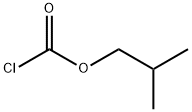Isopropyl chloroformate
- CAS NO.:108-23-6
- Empirical Formula: C4H7ClO2
- Molecular Weight: 122.55
- MDL number: MFCD00075068
- EINECS: 203-563-2
- SAFETY DATA SHEET (SDS)
- Update Date: 2025-09-25 17:15:13

What is Isopropyl chloroformate?
Chemical properties
Isopropyl chloroformate is a colorless liquid with corrosive properties and a pungent odor. generally present as 1.0 mol/L toluene solution of isopropyl chloroformate. It is a highly flammable chemical. Isopropyl chloroformate decomposes when heated, producing toxic and corrosive fumes, including hydrogen chloride and phosgene. The chemical reacts with water to produce alcohol and hydrogen chloride. Hydrolysis would yield chloroformic acid, which is considered a strong acid.
The Uses of Isopropyl chloroformate
Chemical intermediate for free-radical polymerization initiators, organic synthesis.
The Uses of Isopropyl chloroformate
Isopropyl chloroform was used in the preparation of isopropyl cyclohexane via alkylation of cyclohexene. It was also used in the preparation of 10-isopropyloctadecanoic acid via reaction with oleic acid in the presence of ethylaluminum sesquichloride
Production Methods
Prepared by the reaction of liquid anhydrous isopropyl alcohol with molar excess of dry, chlorine-free phosgene at low temperature.
General Description
A clear colorless volatile liquid with a pungent irritating odor. About the same density as water and insoluble in water. Floats on water Flash point 75°F. Very irritating to skin and eyes and very toxic by inhalation, ingestion and skin absorption. Used to make other chemicals.
Air & Water Reactions
Highly flammable. Gives off HCl fumes in moist air. Insoluble in water. Decomposes slowly in water forming isopropyl alcohol, HCl, and CO2.
Reactivity Profile
Isopropyl chloroformate is water reactive. A sample stored in a refrigerator exploded [Wischmeyer 1973]. Attacks many metals especially in humid atmosphere [Handling Chemicals Safely, 1980. p. 476]. May react vigorously or explosively if mixed with diisopropyl ether or other ethers in the presence of trace amounts of metal salts [J. Haz. Mat., 1981, 4, 291].
Hazard
Toxic by inhalation.
Health Hazard
Acute: highly toxic by inhalation, ingestion and skin absorption. Delayed: can produce delayed pulmonary edema (2-24 hours after exposure) similar to that produced by phosgene. Inhalation of material may cause death or permanent injury.
Fire Hazard
Extremely dangerous; Isopropyl chloroformate has exploded while stored in refrigerator. Vapor explosion hazard indoors, outdoors or in sewers. Runoff to sewer may create fire or explosion hazard. Like other chlorides, when heated to decomposition or on contact with acids or acrid fumes, they evolve highly toxic chloride fumes. Reacts violently with phosgene. Unstable, avoid phosgene
Properties of Isopropyl chloroformate
| Boiling point: | 105 °C |
| Density | 0.892 g/mL at 25 °C |
| vapor pressure | 27.998hPa at 20℃ |
| refractive index | n |
| Flash point: | 43 °F |
| storage temp. | 2-8°C |
| solubility | Chloroform (Sparingly), Dichloromethane (Soluble), Ethyl Acetate (Slightly), Tol |
| form | Notspecified |
| BRN | 506416 |
| Stability: | Moisture Sensitive |
| CAS DataBase Reference | 108-23-6(CAS DataBase Reference) |
| EPA Substance Registry System | Isopropyl chloroformate (108-23-6) |
Safety information for Isopropyl chloroformate
| Signal word | Danger |
| Pictogram(s) |
 Flame Flammables GHS02  Corrosion Corrosives GHS05  Skull and Crossbones Acute Toxicity GHS06  Health Hazard GHS08 |
| GHS Hazard Statements |
H225:Flammable liquids H304:Aspiration hazard H314:Skin corrosion/irritation H317:Sensitisation, Skin H330:Acute toxicity,inhalation H336:Specific target organ toxicity,single exposure; Narcotic effects H373:Specific target organ toxicity, repeated exposure |
| Precautionary Statement Codes |
P210:Keep away from heat/sparks/open flames/hot surfaces. — No smoking. P260:Do not breathe dust/fume/gas/mist/vapours/spray. P280:Wear protective gloves/protective clothing/eye protection/face protection. P284:Wear respiratory protection. P301+P310:IF SWALLOWED: Immediately call a POISON CENTER or doctor/physician. P305+P351+P338:IF IN EYES: Rinse cautiously with water for several minutes. Remove contact lenses, if present and easy to do. Continuerinsing. |
Computed Descriptors for Isopropyl chloroformate
| InChIKey | IVRIRQXJSNCSPQ-UHFFFAOYSA-N |
New Products
4,4-Difluoropiperidine hydrochloride tert-butyl 9-methoxy-3-azaspiro[5.5]undecane-3-carboxylate Indole Methyl Resin N-Isopropylurea N,N-Dicyclohexylcarbodiimide(DCC) MELDRUMS ACID 5-METHYLISOXAZOLE-4-CARBOXYLIC ACID Magnessium Bis glycinate Zinc ascorbate 1-bromo-2-butyne 2-acetamidophenol 9(10H)-anthracenone Erythrosin B, 4-Piperidinopiperidine 2-((4-morpholinophenylamino) (methylthio) methylene) malononitrile 2,4-dihydroxybenzaldehyde 3-(4-morpholinophenylamino)-5-amino-1H-pyrazole-4-carbonitrile Methyl 2-methylquinoline-6-carboxylate 2,6-dichloro-4-nitropyridine 4-Bromo-2-chlorobenzonitrile 2-(benzylamino)acetic acid hydrochloride 4-(tert-Butoxycarbonylamino)but- 2-ynoic acid 3,4-dihydro-2H-benzo[b][1,4]dioxepine 1-Phenyl-1-cycloprppanecarboxylicacidRelated products of tetrahydrofuran








You may like
-
 108-23-6 / 94274-22-3 Isopropyl chloroformate 98%View Details
108-23-6 / 94274-22-3 Isopropyl chloroformate 98%View Details
108-23-6 / 94274-22-3 -
 108-23-6 / 94274-22-3 98%View Details
108-23-6 / 94274-22-3 98%View Details
108-23-6 / 94274-22-3 -
 Isopropyl Chloroformate (ca. 30% in Toluene, ca. 2mol/L) CAS 108-23-6View Details
Isopropyl Chloroformate (ca. 30% in Toluene, ca. 2mol/L) CAS 108-23-6View Details
108-23-6 -
 Isopropyl chloroformate solution CAS 108-23-6View Details
Isopropyl chloroformate solution CAS 108-23-6View Details
108-23-6 -
 3-(4-amino-1-oxoisoindolin-2-yl)-1-methylpiperidine-2,6-dione 98%View Details
3-(4-amino-1-oxoisoindolin-2-yl)-1-methylpiperidine-2,6-dione 98%View Details -
 20677-73-0 (2,2-diethoxyethyl)methylamine 98%View Details
20677-73-0 (2,2-diethoxyethyl)methylamine 98%View Details
20677-73-0 -
 3-(4-(hydroxyamino)-1-oxoisoindolin-2-yl)piperidine-2,6-dione 98%View Details
3-(4-(hydroxyamino)-1-oxoisoindolin-2-yl)piperidine-2,6-dione 98%View Details -
 57381-49-4 2-bromo-4-chlorobenzonitrile 98%View Details
57381-49-4 2-bromo-4-chlorobenzonitrile 98%View Details
57381-49-4
